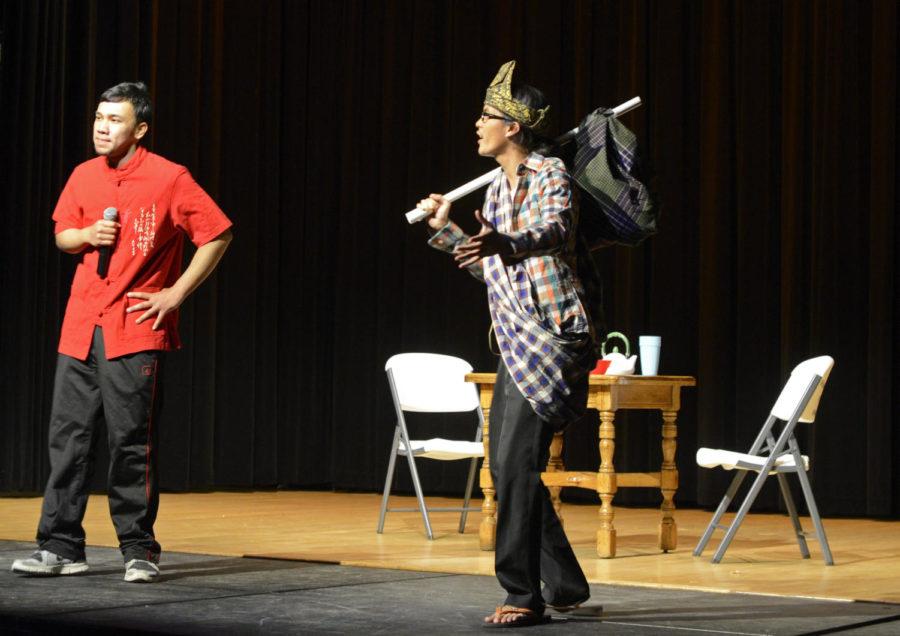Malaysian students share culture at Iowa State
Charlie Coffey/Iowa State Daily
Members of the Association of Malaysian Students at Iowa State University perform a play on March 27 in the Memorial Union during Malaysian Cultural Night 2016.
March 27, 2016
The Memorial Union became a hub of Malaysian culture on Sunday night.
The Association of Malaysian Students at ISU (AMSISU) and Tourism Malaysia reminded ISU students and staff of the beauty of Malaysian culture Sunday night.
“We [want] the Iowan community to know more about Malaysia, and as representation of Malaysia [at Iowa State], we want to teach people about our culture and our food,” said Nurul-Faziera Mohd-Adznan, president of AMSISU.
Tired of people only knowing where Malaysia is on a map, AMSISU wants people to know who Malaysians are as a people.
“We don’t just want people to know that Malaysia is right about [next to] Singapore,” said Farahaini Abdul Rahim, senior in economics and vice president of AMSISU. “We want people to know what Malaysia is, what ethnicities and races we have and who we are.”
Adznan, Rahim and more than 50 other club members and volunteers spent a year planning and organizing for Sunday night’s festivities.
This annual event sought to highlight the three major ethnicities present in Malaysia today–Malays, Chinese and Indian–and and promote the theme of kampong, or village/family.
The meaning behind the theme was revealed by the program’s director, Benjamin Faiz, senior in biology, during the event’s opening speech.
“The word kampong, it literally means the word village, but to a Malaysian it means so much more,” Faiz said.
“It represents an ideal society where people look out for each other. If something happens to your family, that’s my problem and not just your problem. And that’s why we chose this theme.”
For that reason, the event provided an exhibit that featured replicas of standard Chinese homes, complete with a Mahjong game and customary tea set in the corner and traditional Malay dance performances with Indian music filling the air.
Malaysian Cultural Night made certain that the Malaysian way of life was prevalent.
Many students, whether they helped plan the event or only attended, believed the exhibit accurately portrayed the Malaysian way of life so well that it started stirring a feeling of homesickness.
“The best part about the event is the vibe of bringing Malaysia [here],” said Adam Harith, who is an open-option sophomore.
Harith, who has not visited his home country of Malaysia in many months, felt the artificial props truly added to the cultural experience and brought memories to his mind.
“I’ve been away for four months and [this] brings back traditions. From the trees, houses … it brings it all back.”
Malaysian students also made sure to wear their traditional apparel to add to the night’s fun.
Syed Muhammad Syed Putra, junior in mechanical engineering, wore his baju melayu Malay outfit that consisted of a dazzling, purple long sleeve shirt with a stiff collar, matching trousers and a skirt-like adornment known as kain sarung or kain samping.
“The baju malayu are worn during special occasions but there is another version that doesn’t have a stiff collar that can be worn casually,” Putra said.
Annual traditions and customs from around Malaysia were also celebrated and portrayed in the exhibit as well as in the performances that followed.
A rendition of the traditional Chinese Lion dance that is historically performed during Chinese New Year to bring about “good luck, fortune and rid the people of evil spirits,” was executed during the first part of the performances, followed by a play that highlighted the importance of kampong.
The audience laughed at the jokes in the play, clapped at the dance performances and continuously cheered on their friends and family on the stage.







